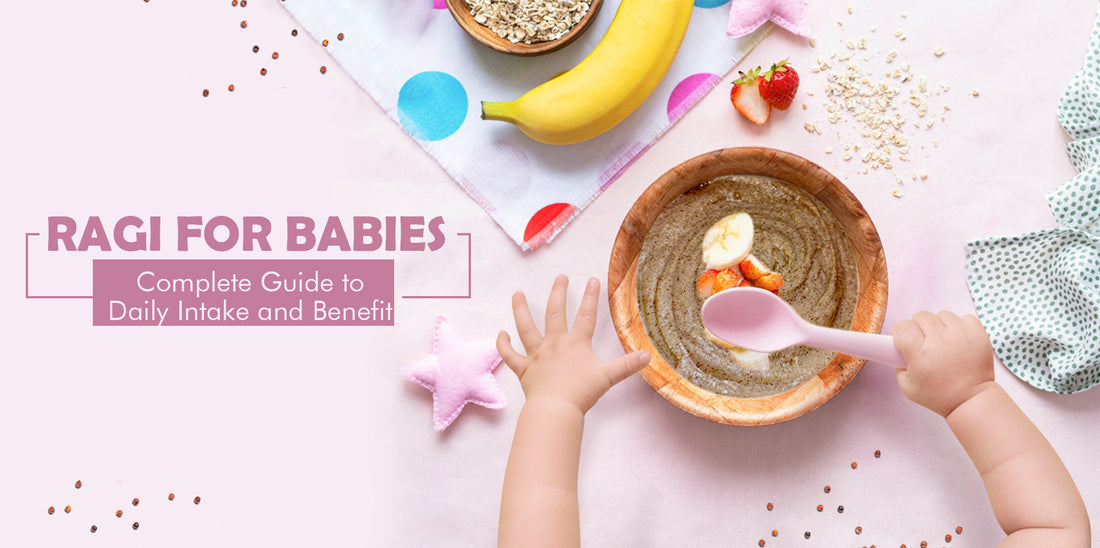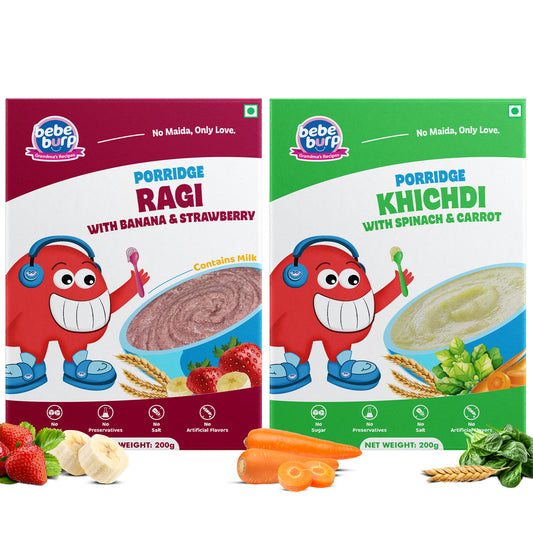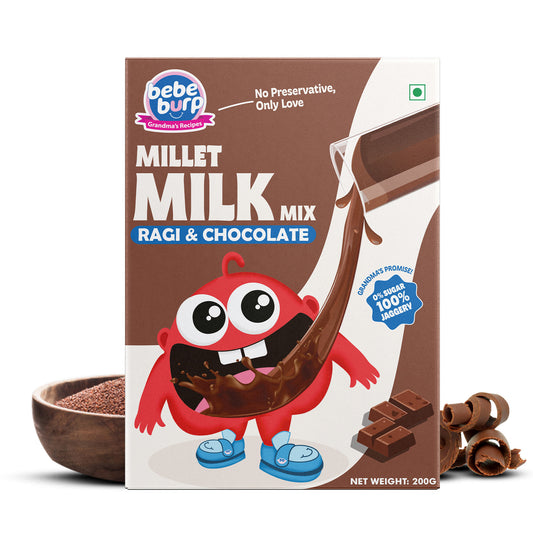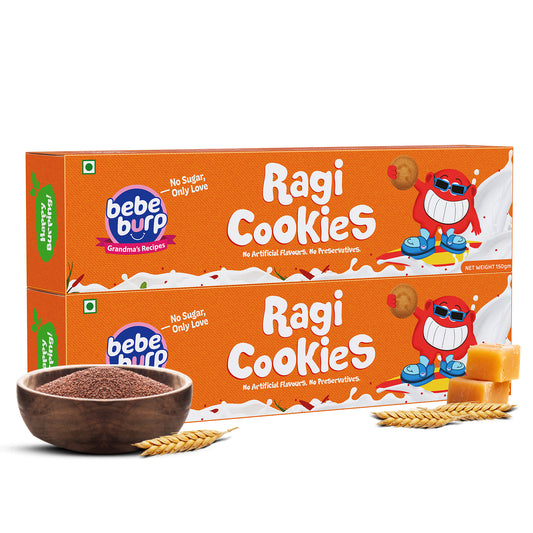Solid food introduction becomes necessary when your baby reaches its sixth month, and ragi for babies is one of the best food choices to consider.
Finger millet, or ragi, is a superfood for babies because it provides digestive ease and nutritional benefits.
The correct methods of feeding ragi to your baby remain unclear. Which method should you use for its preparation? What particular advantages come from this eating?
In this guide, we will explain everything there is to know about babies and ragi, from its best age of introduction to the recommended serving portion.
Do not worry; we have included simple recipes and fun mealtime creative suggestions.
What You Will Learn:
- Benefits of ragi for babies
- How to prepare ragi for babies (detailed instructions)
- When to introduce ragi into the diet
- creative recipes for ragi
- Drawbacks and side effects of ragi
So, let's begin!
Ragi Benefits for Babies: Why It's a Superfood
 Ragi provides tasty nutrition containing essential nutrients that positively drive your baby's development.
Ragi provides tasty nutrition containing essential nutrients that positively drive your baby's development.
Because of these critical health reasons, people should include this item in their children's diet plans.
- Rich in calcium: Offers assistance with muscle and teeth growth.
- Enriched with Iron: Supports measures against anemia.
- Free of Gluten: Suitable for infants that have gluten intolerance. It contains fibre, which helps overcome constipation and supports good digestion.
- Excellent source of protein: Aids in the growth of the body and the brain.
It is well known that parents view ragi as a staple food for their children due to its outstanding nutritional value.
Best Time to Give Ragi for Babies
Are you not sure when to start? Ragi is best introduced to infants around 6 months. At this stage, babies are ready to consume solids, and ragi is suitable for their delicate tummies.
- 6-8 months: Begin off with a runny and smooth rice porridge.
- 9-12 months: Gradually thicken the porridge while adding mashed fruits and vegetables.
- 12 months and above: At this stage, you can introduce the child to different varieties of ragi, such as ragi balls and ragi pancakes.
Please see your pediatrician before adding anything new to your diet.
How to Make Ragi for Babies: Simple Recipe
 The preparation of baby-friendly ragi requires very little time and effort. The following simple ragi porridge preparation requires the following ingredients:
The preparation of baby-friendly ragi requires very little time and effort. The following simple ragi porridge preparation requires the following ingredients:
Ingredients:
2 tbsp ragi flour
1 cup water or breast milk/formula
1 tsp ghee (optional)
Method:
- Heat the ragi flour at a low temperature until it becomes light brown.
- Stir the roasted flour with water or milk while continuously mixing to prevent lump formation.
- The mixture requires 5–7 minutes of cooking until the consistency turns thick.
- Extra flavour and nutrition in the dish can be achieved by adding ghee.
- Serve the dish after it reaches a suitable room temperature.
Mashing banana or apple, along with other ingredients, will boost the taste of your dish.
Ragi for Baby at 6 Months: Is It Safe?
Ragi is safe for infant eating when served at 6 months old but requires correct preparation methods.
Your infant can easily consume this food because it provides the necessary nutrients.
Begin by feeding baby smooth porridge, then enhance the thickness of the porridge as the baby moves to eating solids.
Always test food reactions by giving each new food to your child individually.
Daily Intake Guidelines: How Much Ragi to Give
 The recommended daily ragi consumption for your baby depends on the age group as follows:
The recommended daily ragi consumption for your baby depends on the age group as follows:
- 6–8 Months: 1–2 tablespoons once a day.
- 9–12 Months: 2–3 tablespoons once or twice daily.
- 12 Months: Adding ragi balls and pancakes or ragi combined with fruits or vegetables provides dietary variety.
- Ragi balls or pancakes: You can give about 2–3 tablespoons of ragi in the form of balls or pancakes, once or twice a day.
- Ragi combined with fruits or vegetables: You can mix ragi with fruits or vegetables for a balanced meal, aiming for about 3–4 tablespoons of ragi in total during the day.
Remember that ragi belongs within a balanced food selection that needs moderate consumption.
Disadvantages of Ragi for Babies: What to Know
It is Important to know these disadvantages that exist in ragi, although it provides many benefits:
Phytates: Consuming ragi affects mineral absorption through antinutrients, which prevent the body from properly absorbing iron minerals.
Soaking or fermenting the ragi product makes the cooking process easier.
Gas or Bloating: Monitor your baby closely for digestive distress. Excessive fibre intake can lead to stomach problems, although the best practice is to begin with small portions.
Allergies: Ragi allergies among babies occur in very few cases.
Regular inspection should be conducted for any indications of allergic response.
When offering ragi to your baby, always watch for any symptoms of discomfort or allergic reaction.
Creative Ragi Recipes for Babies
 People can easily make ragi entertaining for children. Here are some creative ideas:
People can easily make ragi entertaining for children. Here are some creative ideas:
Ragi Pancakes: Mix two tablespoons of ragi flour with banana puree and water before cooking in ghee until the batter turns golden.
The mixture needs to be cooked with ghee until it turns golden to reach finger food quality.
Ragi Balls: Shape ragi balls by combining the flour with chopped vegetables. Steam these creations until they are ready to eat. They are perfect for self-feeding.
Ragi and Fruit Puree: Blending ragi porridge with pureed mango or apple fruits will make it more enjoyable for kids.
The recipes provide wholesome nutrition and maintain diverse food variety because of their exciting nature.
Conclusion
Ragi is an exceptional food source for babies due to its numerous nutrients, which help their bodies develop properly.
Food makers can produce this safe infant ingredient, which is introduced at 6 months old through multiple serving methods, resulting in an enjoyable experience.
Offer ragi to your baby in small amounts while checking for adverse effects and feeding them a well-rounded diet consisting of other wholesome foods.
FAQs
1. Do babies tolerate daily ragi consumption?
Ans: Ragi remains a suitable regular food choice for infants, yet its consumption needs to be controlled. A well-balanced nutritional plan must be provided to the baby.
2. Are there any methods to decrease phytates in ragi?
Ans: Fermenting or soaking ragi before giving it to your baby reduces the phytate content and increases nutrient absorption.
3. Can I store ragi porridge or batter for babies?
Ans: Preparing fresh ragi gives you the best nutritional value, so preparing it right before consumption is ideal. The cooked ragi porridge remains safe for storage in an airtight container inside the refrigerator for 24 hours.
4. Ragi is a food ingredient promoting healthy weight gain in babies.
Ans: Ragi's high-calorie content and healthy proteins and fats make this grain beneficial for weight gain in healthy babies.
5. Can ragi be combined with other foods suitable for infants?
Ans: Yes! Ragi becomes more appealing when small amounts of banana and apple puree or carrots and pumpkin cubes are added.







